

Many of the academics tackling this puzzle of intelligence are part of NSF's Learning and Intelligent Systems (LIS) project. Among them, cognitive psychologist Dr. Neil E. Berthier and colleagues at the University of Massachusetts study human and robot motor behavior. Dr. Berthier's team analyzes how infants use their rapidly budding motor skills, particularly reaching, to explore the world and navigate effectively in new environments. The researchers find that infants are highly active individuals who are constantly exploring their own capabilities, matching their motor skill strategies to their current skills and to the task at hand. The research goal according to Dr. Berthier is "to understand how highly complex intelligent systems could arise from simple initial knowledge through interactions with the environment."
Further pursuing this goal, Dr. Berthier and NSF-funded colleagues in Computer Science and Artificial Intelligence explore how an infant's process in learning to reach can be transferred to intelligent machines. The problems facing the infant are similar to those a robot would face in new environments, hence the beneficial cross-disciplinary effort. For example, while it may seem straightforward to watch a baby reach around an object that suddenly obstructs its path, the act of "obstacle avoidance" is actually a central problem in robotics today. For robots to reach effectively in a complex environment, as people do, they must first "learn" to do so. The researchers are working to quantify the strategic patterns or "control strategies" of infant learning; when these human learning mechanisms are understood, it may be possible to engineer an artificial intelligence system based on human-like interactive learning, so that a robot could learn from experience and easily adapt to a changing environment.
The models and technologies developed from this research also have tremendous implications for realms outside of cognitive psychology and robotics:
Health – The motor-sensory studies on infants suggest possibilities to better understand and help people with motor sensory disorders, such as Parkinson's disease or cerebral palsy, and in other aspects of rehabilitation and medicine.Education – Understanding how humans learn best is helping educators develop better ways to teach children by integrating new learning methods with interactive, collaborative and multisensory technologies.
Industry – Advances in control engineering will continue to help scientists design robots to do our tedious and dangerous work, from automatons wrapping candy bars (they've already saved one company millions of dollars) to rescuing earthquake victims to post-Pathfinder telerobotic exploration of our solar system. The U.S. military also benefits from smarter technologies.
With our commercial climate constantly craving the latest in information technology, these scientific advances will also reach mass scale in the form of ever-smarter machines, such as robotic personal assistants, hotel porters, security guards, "intelligent" rooms and other seamlessly computerized environments serving practical and entertainment purposes.|
| |
| We study the development of reaching by infants because... | |
 | |
| Only rudimentary reaching ability is present at birth... | |
|
| |
 | |
| Older infants use their arms in a sophisticated way to exploit and explore the world... | |
|
| |
 | |
|
The problems facing the infant are similar to those an artificial system would face.
|
|
|
| |
 |
|
|
Dr. Roderic Grupen and colleagues from the University of Massachusetts Laboratory for Perceptual Robotics conduct related research in artificial systems. Click here to see a mpeg movie of a pick-and-place operation involving grasping and obstacle avoidance. | |